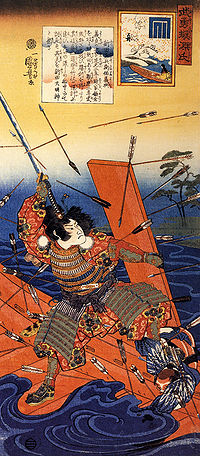
Nitta Yoshioki
Encyclopedia

Nitta family
The ' was one of several major families descended from the Seiwa Genji, and numbered among the chief enemies of the Ashikaga shogunate, and later the Hōjō clan regents...
, who fought for the Imperial Southern Court in the Nanboku-cho
Nanboku-cho
The , spanning from 1336 to 1392, was a period that occurred during the formative years of the Muromachi bakufu of Japan's history.During this period, there existed a Northern Imperial Court, established by Ashikaga Takauji in Kyoto, and a Southern Imperial Court, established by Emperor Go-Daigo in...
period of Japanese history. He was the second son of Nitta Yoshisada
Nitta Yoshisada
was the head of the Nitta family in the early fourteenth century, and supported the Southern Court of Emperor Go-Daigo in the Nanboku-chō period, capturing Kamakura from the Hōjō clan in 1333....
.
Yoshioki aided in the 1333 siege of Kamakura
Siege of Kamakura (1333)
The 1333 siege of Kamakura was a battle of the Genkō War, and marked the end of the power of the Hōjō clan, which had dominated the regency of the Kamakura shogunate for over a century...
, and battled alongside Kitabatake Akiie
Kitabatake Akiie
was a Japanese court noble, and an important supporter of the Southern Court during the Nanboku-chō Wars. He also held the posts of Commander-in-Chief of the Defense of the North, and Governor of Mutsu Province...
. The following year, he fought with Kitabatake Akinobu, fortifying Mt. Otoko, but being soon routed from there and forced to seek refuge at Mt. Yoshino.
The conflict with the Ashikaga clan
Ashikaga clan
The ' was a prominent Japanese samurai clan which established the Muromachi shogunate and ruled Japan from roughly 1336 to 1573.The Ashikaga were descended from a branch of the Minamoto clan, deriving originally from the town of Ashikaga in Shimotsuke province .For about a century the clan was...
continued for several decades, and in 1352, Yoshioki ousted Ashikaga Motouji
Ashikaga Motouji
-See also:* Kamakura, Kanagawa - The Muromachi and Edo periods* The article Nanboku-chō period...
from Kamakura
Kamakura, Kanagawa
is a city located in Kanagawa Prefecture, Japan, about south-south-west of Tokyo. It used to be also called .Although Kamakura proper is today rather small, it is often described in history books as a former de facto capital of Japan as the seat of the Shogunate and of the Regency during the...
, with the aid of his brother Nitta Yoshimune
Nitta Yoshimune
was the third son of Nitta Yoshisada, and a commander of loyalist forces during the Nanbokuchō Wars.In 1352, Yoshimune led a force from Echigo Province to contribute to the loyalist efforts to drive the Shogun, Ashikaga Takauji, from the city...
and cousin Wakiya Yoshiharu. Soon after taking control of the city, however, he was forced out by Ashikaga Takauji
Ashikaga Takauji
was the founder and first shogun of the Ashikaga shogunate. His rule began in 1338, beginning the Muromachi period of Japan, and ended with his death in 1358...
.
Returning to the countryside of Kozuke
Kozuke Province
was an old province located in the Tōsandō of Japan, which today comprises Gunma Prefecture. It is nicknamed as or .The ancient provincial capital was near modern Maebashi. During the Sengoku period, Kōzuke was controlled variously by Takeda Shingen, Uesugi Kenshin, the late Hōjō clan, and...
and Musashi province
Musashi Province
was a province of Japan, which today comprises Tokyo Prefecture, most of Saitama Prefecture and part of Kanagawa Prefecture. It was sometimes called . The province encompassed Kawasaki and Yokohama...
s, Yoshioki continued to fight for some time before being captured by Takezawa Nagahira. He was sentenced to death by the minister of Motouji, Hatakeyama Kunikiyo, and drowned in the Rokugō-gawa
Tama River
The is a major river in Yamanashi, Kanagawa and Tokyo Prefectures on Honshū, Japan. It is officially classified as a Class 1 river by the Japanese government....
. A shrine stands at Yaguchi no watari, the site of his death, and he is revered under the name Nitta-daimyōjin (新田大明神).

